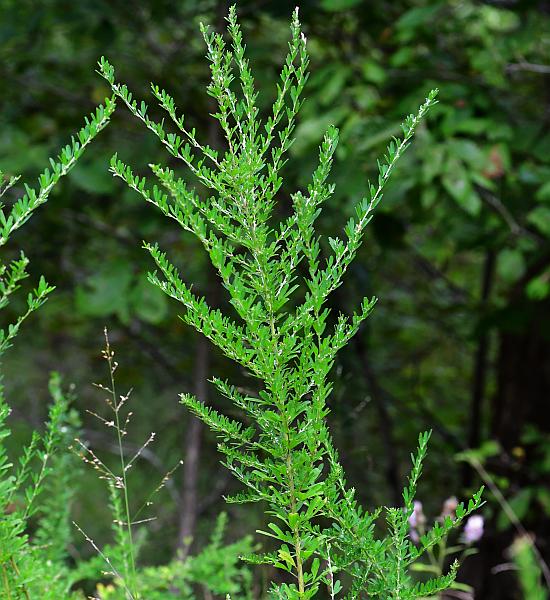Lespedeza cuneata (Dum. Cours.) G. Don
Sericea Lespedeza

Introduced
CC = *
CW = 3
MOC = 78
© SRTurner
Lespedeza cuneata (Dum. Cours.) G. DonSericea Lespedeza | |
 |
Introduced CC = * CW = 3 MOC = 78 |
© SRTurner |
|
Family - Fabaceae/Faboideae Habit - Perennial forb. Stems - Ascending to erect, to 1.5 m, often multiple from a woody caudex, unbranched or branched above the midpoint, densely pubescent with appressed to somewhat spreading hairs mostly confined to conspicuous, white, longitudinal ridges running the length of the stem.
Leaves - Alternate, trifoliate, petiolate, stipulate. Petioles 2-12 mm long (shorter toward the stem tip), densely pubescent with appressed or slightly spreading hairs. Stipules 2-8 mm long, hairlike. Leaflets 1-3 cm long, 2-6 mm wide (mostly more than 3 times as long as wide), those of the uppermost leaves usually smaller, narrowly oblanceolate to narrowly oblong, narrowly angled or tapered at the base, truncate at the tip, but sometimes shallowly notched and usually with an abrupt, minute, sharp point at the very tip, often with a grayish appearance, both surfaces densely appressed-hairy or the upper surface sometimes becoming glabrous. Axillary clusters of leaves sometimes present.
Inflorescences - Axillary clusters of 1-4 flowers from the median and upper leaves, shorter than or nearly equal to the associated leaves.
Flowers - Calyces with the tube 1.0-1.5 mm long, the lobes 2.5-4.0 mm long. Corollas papilionaceous, 5-9 mm long, creamy white with purple markings on the banner, the keel about as long as the wings.
Fruits - Fruits from open flowers 3.0-4.5 mm long, the calyx nearly equal in length; fruits from cleistogamous flowers 2.0-3.5 mm long, the calyx slightly shorter than to somewhat longer than the fruit. Seeds 1.5-2.0 mm long, olive green to brown.
Flowering - August - October. Habitat - Prairies, glades, streambanks, pond margins, fields, quarries, railroads, roadsides, any open disturbed area. Deliberately seeded in the past. Origin - Native to Asia. Lookalikes - L. virginica. Other info. - This aggressive weed is reviled by land managers and concerned property owners across Missouri and the southeastern quadrant of the continental U.S. It thrives in disturbed areas, invades natural communities, and is difficult to eradicate. Even small scale control efforts are hampered by strong rhizomes which make it very difficult to uproot. It spreads rampantly along roadsides and is readily spread by mowing and grading equipment. The decision to deliberately introduce this species for forage, erosion control, soil enrichment, and as a wildlife food source turned out to be spectacularly ill advised. Photographs taken in Brown Summit, NC., 9-18-02 (DETenaglia); also at Tyson County Park, St. Louis County, MO, 9-8-2021, along the Al Foster Trail near Glencoe, St. Louis County, MO, 9-9-2021, and at Don Robinson State Park, Jefferson County, MO, 9-19-2021 (SRTurner). |